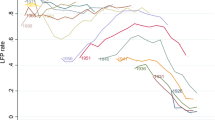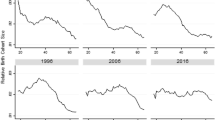Abstract
The age-period-cohort accounting framework is used to describe labor force participation patterns for the sex-color groups over the interval 1969–1979, using data from the March Current Population Survey. A model with a special type of age-period interaction, in addition to main effects of the three indexing variables, is presented as a means of capturing the transitory period “shocks” which differentially influence participation odds for young and old age groups. Findings show that younger cohorts of nonblack men, nonblack women, and black women have greater “intrinsic” tendencies to participate than older cohorts, while younger cohorts of black men have lesser “intrinsic” tendencies to participate than older cohorts. The results are used to decompose across-time change into a part due to cohort effects and a part due to period effects.
Similar content being viewed by others
References
Bancroft, Gertrude. 1958. The American Labor Force: Its Growth and Changing Composition. New York: Wiley.
Bowen, W. G., and T. A. Finegan. 1969. The Economics of Labor Force Participation. Princeton, N.J.: Princeton University Press.
Clogg, Clifford C. 1978. Adjustment of Rates Using Multiplicative Models. Demography 15:523–539.
—. 1979. Measuring Underemployment: Demographic Indicators for the United States. New York: Academic Press.
—. 1982a. A Note on the Identification Problem in Age-Period-Cohort Models for the Analysis of Archival Data. In O. D. Duncan and H. H. Winsborough (eds.), Cohorts in the Analysis of Social Change. New York: Academic Press (forthcoming).
Clogg, Clifford C. 1982b. Some Models for the Analysis of Association in Multi-Way Cross-Classification Having Ordered Categories. Journal of the American Statistical Association (in press).
Clogg, C. C., and T. A. Sullivan. 1982. Labor Force Composition and Underemployment Trends, 1969–1980. Social Indicators Research (in press).
Duncan, B. 1979. Change in Worker/Nonworker Ratios for Women. Demography 16:535–547.
Duncan, O. D., and H. H. Winsborough (eds.). 1982. Cohorts and the Analysis of Social Change. New York: Academic Press.
Durand, John D. 1948. The Labor Force in the United States, 1890–1960. New York: Gordon and Breach Science Publishers.
Easterlin, R. A. 1978. What Will 1984 Be Like? Socioeconomic Implications of Recent Twists in Age Structure. Demography 15:397–432.
—. 1980. Birth and Fortune: The Effects of Generation Size on Personal Welfare. New York: Basic Books.
Eck, A. 1980. Using Current Population Survey Data to Measure Labor Force Movements. Paper presented to the Annual Meeting of the Population Association of America, Denver, Colorado.
Farkas, G. 1977. Cohort, Age, and Period Effects upon the Employment of White Females: Evidence for 1957–1968. Demography 14:33–42.
Fay, R. E. 1979. On Jackknifing Chi-Square Test Statistics—Part I: An Application to Log-Linear Modeling of Data from the Current Population Survey. Unpublished manuscript.
Fienberg, S. E., and W. M. Mason. 1978. Identification and Estimation of Age-Period-Cohort Models in the Analysis of Discrete Archival Data. Pp, 1–67 in Karl F. Schuessler (ed.), Sociological Methodology 1979. San Francisco: Jossey-Bass.
Flaim, P. O. 1972. Discouraged Workers and Changes in Unemployment. Monthly Labor Review 95:8–16.
Glenn, N. D. 1977. Cohort Analysis. Beverly Hills: Sage.
Goodman, L. A. 1972. Some Multiplicative Models for the Analysis of Cross Classified Data. Pp. 649–696 in L. LeCam, J. Neyman, and E. L. Scott (eds.), Proceeding of the Sixth Berkeley Symposium on Mathematical Statistics and Probability. Vol. I. Berkeley: University of California Press.
—. 1979. Simple Models for the Analysis of Association in Cross-Classifications Having Ordered Categories. Journal of the American Statistical Association 74:537–552.
Gustafsson, S. 1979. Lifetime Patterns of Labor Force Participation. Paper No. 34, Center for the Social Sciences at Columbia University, New York.
Haberman, Shelby J. 1978. Analysis of Qualitative Data. Vol. I. Introductory Topics. New York: Academic Press.
Heckman, J. 1974. Shadow Prices, Market Wages, and Labor Supply. Econometrica 42:679–1674.
Levitan, Sar A., and R. Taggart. 1974. Employment and Earnings Inadequacy: A New Social Indicator. Baltimore: Johns Hopkins University Press.
Long, C. D. 1958. The Labor Force Under Changing Income and Employment. Princeton, N.J.; Princeton University Press.
Mincer, J. 1962. Labor Force Participation of Married Women. Pp. 63–97 in Aspects of Labor Economics: A Conference of the Universities National Bureau Committee for Economic Research. Princeton, N.J.: Princeton University Press.
Oppenheimer, Valerie K. 1970. The Female Labor Force in the United States: Demographic and Economic Factors Governing Its Growth and Changing Composition. Population Monograph Series No. 5. Berkeley: University of California Press.
Pullum, T. W. 1977. Parametrizing Age, Period, and Cohort Effects: An Application to U.S. Delinquency Rates. Pp. 116–140 in Karl F. Schuessler (ed.), Sociological Methodology 1978. San Francisco: Jossey-Bass.
—. 1980. Separating Age, Period, and Cohort Effects in White U.S. Fertility, 1920–1970. Social Science Research 9:225–244.
Reimers, C. 1976. Is the Average Age at Retirement Changing? Journal of the American Statistical Association 71:552–558.
Robinson, J. G. 1980. Labor Force Participation Rates of Cohorts of Women in the United States: 1890–1979. Paper presented to the Annual Meeting of the Population Association of America, Denver, Colorado.
Ryder, N. B. 1964. The Process of Demographic Translation. Demography 1:74–82.
—. 1965. The Cohort as a Concept in the Study of Social Change. American Sociological Review 30:843–861.
—. 1969. The Emergence of a Modern Fertility Pattern: United States 1917–66. Pp. 99–126 in S. J. Behrman, L. Corsa, Jr., and R. Freeman (eds.), Fertility and Family Planning. Ann Arbor: University of Michigan Press.
Sullivan, Teresa A. 1978. Marginal Workers, Marginal Jobs: The Underutilization of American Workers. Austin: The University of Texas Press.
Sweet, James A. 1973. Women in the Labor Force. New York: Seminar Press.
U.S. Bureau of the Census. 1978. The Current Population Survey: Design and Methodology. Technical Paper No. 40. Washington, D.C.: U.S. Government Printing Office.
U.S. Bureau of Labor Statistics. 1969–1979. Employment and Earnings. Vols. 15–22, 24–26, No. 10 (April). Washington, D.C.: U.S. Government Printing Office.
—. 1980. Measuring Labor Force Movements: A New Approach. Report 581. Washington, D.C.: U.S. Government Printing Office.
U.S. Commission on Employment and Unemployment Statistics. 1979. Counting the Labor Force. Washington, D.C.: U.S. Government Printing Office.
Weiss, Y., and L. A. Lillard. 1978. Experience, Vintage, and Time Effects in the Growth of Earnings: American Scientists. Journal of Political Economy 86:427–447.
Welch, F. 1979. Effects of Cohort Size on Earnings. Journal of Political Economy 87:565–598.
Wilson, William J. 1980. The Declining Significance of Race. Second Edition. Chicago: University of Chicago Press.
Winsborough, H. H. 1978. Statistical Histories of the Life Cycle of Birth Cohorts: The Transition from Schoolboy to Adult Male. Pp. 231–259 in K. E. Taueber, L. L. Bumpass, and J. A. Sweet (eds.), Social Demography. New York: Academic Press.
Wunsch, Guillaume J., and Marc G. Termote. 1978. Introduction to Demographic Analysis: Principles and Methods. New York: Plenum Press.
Author information
Authors and Affiliations
Rights and permissions
About this article
Cite this article
Clogg, C.C. Cohort Analysis of Recent Trends in Labor Force Participation. Demography 19, 459–479 (1982). https://doi.org/10.2307/2061013
Issue Date:
DOI: https://doi.org/10.2307/2061013




